中国历史文化概况(英文版)Unit (10)
- 格式:ppt
- 大小:1.62 MB
- 文档页数:32

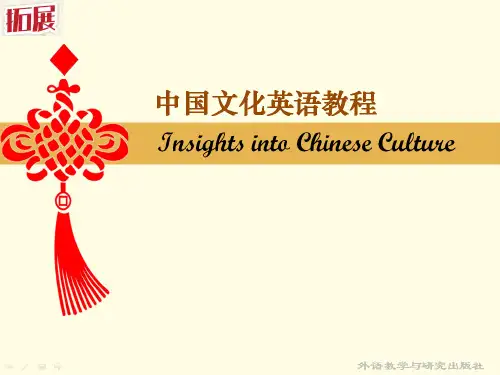

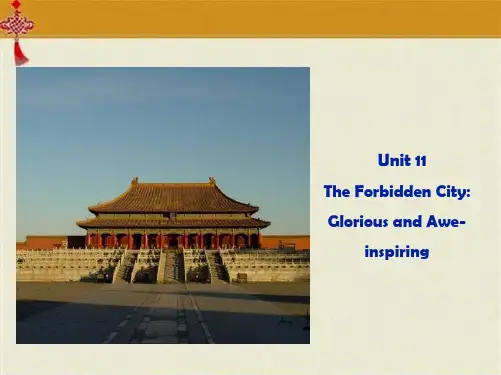
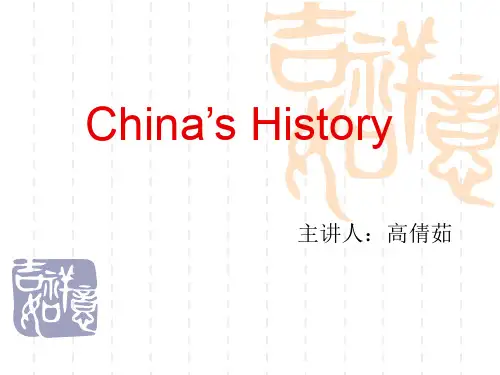
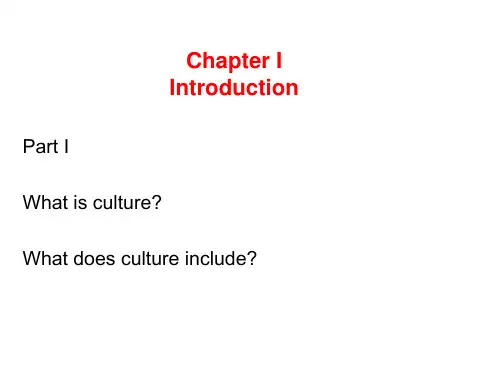
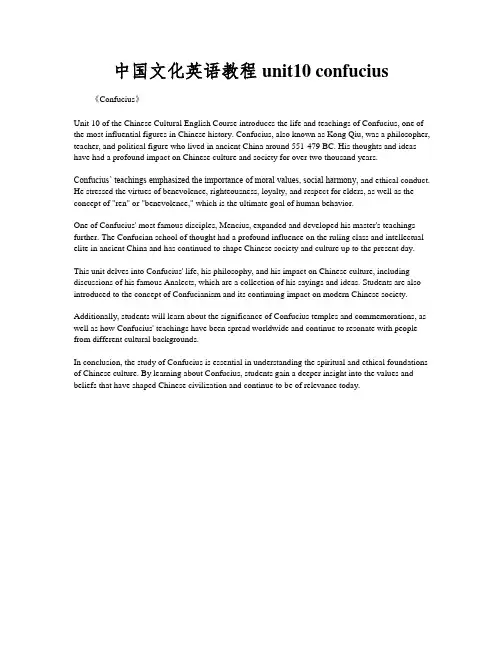
中国文化英语教程 unit10 confucius 《Confucius》Unit 10 of the Chinese Cultural English Course introduces the life and teachings of Confucius, one of the most influential figures in Chinese history. Confucius, also known as Kong Qiu, was a philosopher, teacher, and political figure who lived in ancient China around 551-479 BC. His thoughts and ideas have had a profound impact on Chinese culture and society for over two thousand years.Confucius’ teachings emphasized the importance of moral values, social harmony, and ethical conduct. He stressed the virtues of benevolence, righteousness, loyalty, and respect for elders, as well as the concept of "ren" or "benevolence," which is the ultimate goal of human behavior.One of Confucius' most famous disciples, Mencius, expanded and developed his master's teachings further. The Confucian school of thought had a profound influence on the ruling class and intellectual elite in ancient China and has continued to shape Chinese society and culture up to the present day. This unit delves into Confucius' life, his philosophy, and his impact on Chinese culture, including discussions of his famous Analects, which are a collection of his sayings and ideas. Students are also introduced to the concept of Confucianism and its continuing impact on modern Chinese society.Additionally, students will learn about the significance of Confucius temples and commemorations, as well as how Confucius' teachings have been spread worldwide and continue to resonate with people from different cultural backgrounds.In conclusion, the study of Confucius is essential in understanding the spiritual and ethical foundations of Chinese culture. By learning about Confucius, students gain a deeper insight into the values and beliefs that have shaped Chinese civilization and continue to be of relevance today.。

China's Historical Overview in English(16 Pages)Page 1: Ancient China (Prehistoric Era to Qin Dynasty)The history of China stretches back over 5,000 years, beginning with the prehistoric era when early humansinhabited the region. The Xia Dynasty, though largely mythical, is often considered the first dynasty of China. The Shang Dynasty, which followed, left behind the earliest written records and a rich collection of bronze artifacts. The Zhou Dynasty saw the development of Confucianism and Taoism, two of the major philosophical systems that would shape Chinese culture.Page 2: The Spring and Autumn Period and the Warring States PeriodThe Spring and Autumn Period, named after the chronicle "The Spring and Autumn Annals," was a time of rapid social and political change. This era was marked the decline of the Zhou Dynasty and the rise of several states vying for power. The subsequent Warring States Period was a period of intense warfare and philosophical development, including the birth of Legalism.Page 3: The Qin Dynasty (221206 BC)The Qin Dynasty, though shortlived, was pivotal in Chinese history. Qin Shi Huang, the first emperor of aunified China, standardized the writing system, currency, and measurements. He also began construction of the Great Wall and the Terracotta Army, which continues to astound visitors today.Page 4: The Han Dynasty (206 BC AD 220)The Han Dynasty is often cited as one of the golden ages of Chinese history. It saw the expansion of the Silk Road, which facilitated trade and cultural exchange with the West. The Han Dynasty also saw the development of Buddhism in China and the establishment of a civil service system based on merit.Page 5: The Three Kingdoms, Jin Dynasty, and the Southern and Northern DynastiesThe Three Kingdoms period, romanticized in the historical novel "Romance of the Three Kingdoms," was a time of fragmentation and warfare following the fall of the Han Dynasty. The Jin Dynasty reunified the north, but the country soon split again into the Southern and Northern Dynasties, leading to a period of cultural diversity and technological innovation.Page 6: The Sui Dynasty (581618)The Sui Dynasty, though shortlived, managed to reunify China. It is known for the construction of the Grand Canal, which linked the Yellow River and the Yangtze River, facilitating trade and transportation across the vast territory.Page 7: The Tang Dynasty (618907)The Tang Dynasty is renowned for its cultural achievements and economic prosperity. It is often referred to as the "Age of Unity andProsperity." The Tang Dynasty saw the flourishing of poetry, with poets like Li Bai and Du Fu, and the expansion of foreign trade along the Silk Road.Page 8: The Five Dynasties and Ten Kingdoms Period (907960)The Five Dynasties and Ten Kingdoms period was a time of political fragmentation. Despite the lack of a central authority, this era saw the continuation of cultural and economic developments, particularly in the south.(To be continued)Page 9: The Song Dynasty (9601279)The Song Dynasty is celebrated for its economicrevolution and cultural advancements. The era saw the early development of a market economy, the introduction of paper money, and remarkable innovations in agriculture and technology. The Song Dynasty also nurtured a flourishing ofthe arts, with landscape painting reaching new heights andthe philosophical school of NeoConfucianism gaining prominence.Page 10: The Yuan Dynasty (12711368)Established the Mongolian leader Kublai Khan, the Yuan Dynasty marked the first time that all of China was ruled nonHan Chinese. The Yuan Dynasty is notable for its patronage of the arts and its administrative organization, whichincluded the establishment of the Yuan Shikai, a precursor to modernday postal systems.Page 11: The Ming Dynasty (13681644)The Ming Dynasty is renowned for its maritime expeditions, notably those led the explorer Zheng He, which reached asfar as Africa and the Middle East. The dynasty is also famous for its architectural achievements, including theconstruction of the Forbidden City and the reinforcement ofthe Great Wall. The Ming era saw a flourishing of literature and drama, with the latter exemplified the works of Tang Xianzu.Page 12: The Qing Dynasty (16441912)The Qing Dynasty, established the Manchu people, was the last imperial dynasty of China. It reached its territorial zenith under Emperors Kangxi and Qianlong, expanding China's borders to include Tibet, Xinjiang, and Mongolia. However,the latter part of the dynasty was marked internal strife, foreign invasions, and the humiliating Boxer Protocol, leading to the decline of imperial power.Page 13: The Xinhai Revolution and the Republic of China The Xinhai Revolution of 1911 led to the overthrow of the Qing Dynasty and the establishment of the Republic of China under the leadership of Sun Yatsen. The early years of the republic were tumultuous, with warlordism and the strugglefor power between the Nationalist Party (Kuomintang) and the Communist Party.Page 14: The Chinese Civil War and the Establishment of the People's Republic of ChinaThe Chinese Civil War, which began in the late 1920s and ended in 1949, resulted in the victory of the Communist Party and the establishment of the People's Republic of China Mao Zedong. The new regime implemented sweeping land reforms and began the process of collectivization, which would have profound effects on Chinese society.Page 15: The Cultural Revolution and its AftermathThe Cultural Revolution, initiated Mao Zedong in 1966, was a radical sociopolitical movement aimed at purging remnants of capitalist and traditional elements from Chinese society. It led to widespread violence and the destruction of historical artifacts. The period following the CulturalRevolution was marked a shift towards economic reform and opening up to the world.Page 16: Modern China and the Path to the FuturePage 17: The Reform and Openingup PolicyDeng Xiaoping's leadership in the late 1970s brought about the Reform and Openingup Policy, which transformed China's economy from a centrally planned system to a market economy. This policy allowed foreign investment, established special economic zones, and encouraged private enterprise. The result was an economic boom that lifted hundreds of millions out of poverty and turned China into a global manufacturing hub.Page 18: The Rise of China's Tech GiantsPage 19: China's Space ExplorationChina's space program has made significant strides, including the successful launch of the Shenzhou spacecraft series and the construction of the Tiangong Space Station. In 2020, China became the second country to land a rover on the far side of the moon, demonstrating its ambition and capability in space exploration.Page 20: Environmental Challenges and Green InitiativesPage 21: Belt and Road InitiativeAnnounced in 2013, the Belt and Road Initiative is a global development strategy aimed at enhancing regionalconnectivity and economic integration. It involves infrastructure development and investments in countries across Asia, Europe, and Africa. The initiative reflects China's desire to take a more active role in global affairs and to expand its influence.Page 22: China's Role in Global DiplomacyChina has increasingly engaged in global diplomacy, playing a key role in international organizations such as the United Nations. It has also established strategic partnerships with countries around the world. However,China's assertiveness in regional disputes, particularly in the South China Sea, has raised concerns about its geopolitical intentions.Page 23: The Pursuit of Soft PowerRecognizing the importance of soft power, China has been promoting its culture and language through initiatives like the establishment of Confucius Institutes worldwide. These institutes offer Chinese language and cultural courses, contributing to the global spread of Chinese language and culture.Page 24: ConclusionChina's history is a tapestry of dynasties, revolutions, and rapid modernization. From the ancient dynasties that laid the foundation for Chinese civilization to the modern era oftechnological advancement and global engagement, China's story is one of resilience, innovation, and transformation. As China continues to evolve, its historical narrative will no doubt continue to influence its role on the world stage.。

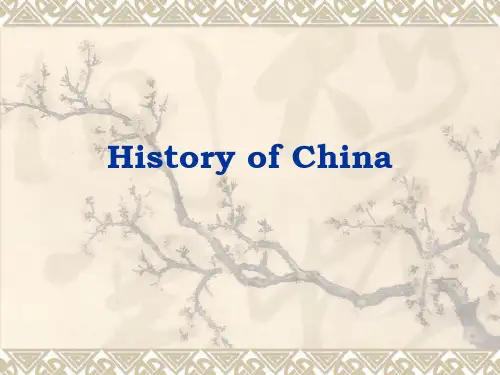

中国文化概况英汉对照版中国文化概况英汉对照版一:英文版:Chinese culture, with its rich heritage spanning thousands of years, is one of the oldest and most diverse cultures in the world. It is a blend of traditions, art, philosophy, and customs that have been shaped by the vast and diverse geography of China. From the ancient times of the Yellow Emperor and Confucius to the modern era, Chinese culture has continuously evolved while maintaining its unique identity.At the heart of Chinese culture lies its philosophical traditions, including Confucianism, Taoism, and Buddhism. These philosophies have profoundly influenced the moral and social values of the Chinese people. Confucianism, for instance, emphasizes the importance of family, respect for elders, and the pursuit of knowledge and wisdom.Chinese art, another vital aspect of its culture, encompasses a wide range of styles and mediums, including painting, calligraphy, sculpture, and ceramics. Chinese painting, known for its use of brush and ink, often depicts natural landscapes and scenes from history and mythology. Calligraphy, considered both an art and a way to cultivate one's character, is highly revered in Chinese culture.Cuisine is also a significant part of Chinese culture, characterized by its diversity and emphasis on harmony and balance. Chinese cuisine varies greatly from region to region, with each area having its own unique flavors and specialties. Traditional Chinese medicine, with its holistic approach to health, is another important aspect of the culture.Lastly, Chinese festivals and customs play a crucial role in cultural expression. The Spring Festival, or Chinese New Year, is the most important and widely celebrated festival in China. It is a time for family reunions, feasting, and the giving of red envelopes. Other notable festivals include the Dragon Boat Festival, Mid-Autumn Festival, and Lantern Festival, each with its own traditions and significance.汉语对照版:中国文化,拥有数千年的丰富遗产,是世界上最古老、最多样化的文化之一。
中国文化概况中英版An Overview of Chinese Culture (English Version)I. IntroductionChinese culture, with its long history and profound essence, is the sum of material and spiritual cultures created and passed down by the Chinese nation throughout its historical development. Chinese culture emphasizes humanism, focusing on moral values, etiquette, family, and social order.II. Main Contents1. History and EvolutionChinese culture boasts a rich history spanning thousands of years, from the Xia, Shang, and Zhou dynasties to the Spring and Autumn period, the Warring States period, and then to the Tang, Song, Yuan, Ming, and Qing dynasties. It has continuously absorbed and integrated foreign cultures, forming a unique cultural system.2. Traditional ValuesConfucianism is one of the cornerstones of Chinese culture, emphasizing virtues such as benevolence, filial piety, loyalty, and etiquette, which have profoundly influenced the behavior and values of the Chinese people. Taoism emphasizes the harmony between man and nature, advocating a natural and non-interventionist approach. Buddhism, on the other hand, emphasizes compassion and self-sacrifice, having a significant impact on Chinese religion and philosophy.3. Cultural Characteristics- Festival Culture: China has many traditional festivals, such as the Spring Festival, Mid-Autumn Festival, and Dragon Boat Festival, each with unique celebration methods and cultural connotations.- Clothing Culture: Traditional Chinese clothing, such as Hanfu and Tangzhuang, reflects the unique aesthetic concepts and cultural characteristics of the Chinese nation.- Architectural Culture: Traditional Chinese architecture, including palaces, temples, and gardens, is renowned for its distinctive styles and exquisite craftsmanship.- Cuisine Culture: Chinese cuisine, known for its rich flavors and exquisiteculinary techniques, is an important representation of China's cultural charm.4. Influence on the WorldThe values and ideological systems of Chinese culture have had a profound impact on the world, especially Confucianism, which has influenced Asia and beyond. Traditional Chinese arts and forms of expression, such as calligraphy, painting, and Peking Opera, are also deeply loved and admired by people around the world.III. ConclusionChinese culture is a treasure of the Chinese nation, embodying unique charm and value. Through learning and understanding Chinese culture, we can gain a deeper understanding of the history, traditions, and spiritual outlook of the Chinese people, further enhancing our sense of national pride and self-confidence. At the same time, Chinese culture has also made significant contributions to the diversity and development of world culture.中国文化概况中英版一、引言中国文化,源远流长,博大精深,是中华民族在长期历史发展过程中所创造并传承下来的物质文化和精神文化的总和。